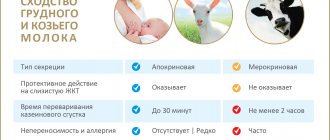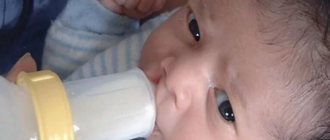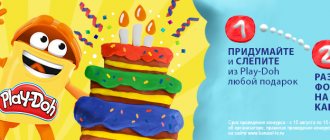Updated: 05/10/2021 17:56:52
Not all mothers are ready to breastfeed their baby, but at the same time they do not want to deprive the baby of breast milk. Therefore, they decide to pump and bottle feed the baby.
This is also an excellent solution to the problem when you need to leave home for a while or go to work. The baby receives proper nutrition, but the mother does not need to be nearby at this moment.
Let's look at all the questions that relate to feeding a baby with expressed milk.
What do you need to express milk?
In order to express milk and feed it to your baby, you will need additional “tools”:
- Bottle with nipple
. Bottles vary in material (plastic or glass), shape, volume, and the presence of an anti-colic system. Nipples are available in latex (the softest and most elastic, suitable for weak children) and silicone (more elastic).
- Breast pump
. You can express milk from the breast with your hands, but the process is long, painful, and not all mothers know how to do it correctly. Breast pumps are distinguished in many ways, but most importantly, they are manual and automatic. With the latter, the process goes much faster.
- Bottle sterilizer.
It is needed to treat children's dishes to destroy all harmful bacteria. Sterilizers can be steam (steam treatment), ultraviolet (treatment with UV rays), cold (processing using a special safe tablet), for microwaves (work only in a microwave oven).
- Bottle warmer.
The device warms breast milk to a comfortable temperature. Only needed if you store expressed milk in the refrigerator for some time. If you express and feed the baby right away, then there is no need for it.
- Bags for storing and freezing milk.
It is worth remembering that breast milk can be stored at room temperature for no more than 10 hours, in the refrigerator for 4-5 days, and in the freezer for 3 to 6 months.
- Cooler bag
will save a young mother if she feeds her baby with expressed milk outside the home. This thing is especially relevant in warm and hot weather.
Not all of these items are required. But if you don’t want to spend a lot of time on the pumping process and want to make the feeding procedure as safe as possible for your baby, then think about purchasing them.
Rules for storing milk
After the milk has been expressed, it must be left for a while at room temperature. This is done if you are not going to feed the baby right away. After standing for half an hour, you can put it in the refrigerator. There it can be stored for 2-3 days. But the best option is to freeze it and store it in the freezer.
To store in the freezer, it is necessary to pour milk into special disposable bags. They must be clearly marked: the date and time when it was expressed. Since expired milk is not suitable for feeding a child and must be disposed of.
In the refrigerator, milk can be stored in a bottle or glass container. They also need to be marked with date and time. However, before each use they must be thoroughly washed and sterilized. When storing in the refrigerator, containers should be placed as close to the freezer as possible and in no case in the door, since the temperature is much lower.
The milk itself does not need to be sterilized. Before use, warm it up to room temperature naturally or with hot water, but under no circumstances in the microwave.
How long you can store expressed milk depends on the temperature around it.
| storage temperature, °C | storage time |
| 18 — 22 | 10 hours |
| up to 26 | 6 hours |
| 15 — 18 | 8 ocloc'k |
| from 0 to 10 (in the refrigerator) | 4 – 8 days |
| from -10 to 0 | from 1 to 3 months |
| from -20 to -10 | from 6 to 12 months |
How to teach a child to drink from a bottle?
Not all babies immediately recognize bottles after their mother's breast. They begin to be capricious, cry, spit out the pacifier. But if you definitely decide to feed your baby with expressed milk, then lactation specialists from the famous foreign organization for supporting breastfeeding women “La Leche League” give recommendations on how to properly organize this process.
The very first
: It is recommended to accustom your baby to a bottle at 4 weeks, not earlier. By this period, the mother will have established lactation, and the baby will begin to latch onto the breast correctly.
Don't offer a bottle when your baby is hungry. This is not the best time to learn new skills. Moreover, it is better to offer a new feeding option not to the mother herself, but to the father, grandmother or nanny. The baby is unlikely to eat from a container if the person who usually breastfeeds it is nearby.
You can try to cheat and wrap the bottle in clothes that smell like mom. In this case, it is better to maintain skin-to-skin contact, as occurs during breastfeeding.
Don't forget to change your position
. Perhaps it will be more convenient for the baby to eat on his side, or maybe in a seated position (for older children). Also try changing the nipple, its temperature, and the temperature of the milk. All kids have different tastes.
Give your baby a pacifier the same way you would a breast. Pass it over the baby's lips so that he reflexively opens his mouth, and then place it in his mouth. The baby should fully grasp the nipple the same way he grasps the mother's nipple.
Lastly, tilt the bottle periodically to stop the milk flowing. This way you can make the process similar to breastfeeding.
Bottle feeding rules
How to feed a child with expressed milk there are also several rules that should be followed strictly, since the health and even the life of the child depends on some of them.
- The main thing is to never leave your baby alone with a bottle. Even when he already knows how to hold it himself, he can choke. This is dangerous for his life.
- If you want to breastfeed your baby, you need to hold him in your arms in the same position as usual when breastfeeding.
- Unlike bottle feeding, when feeding a baby with expressed breast milk, the frequency should not be limited. As with breastfeeding, here it is primarily feeding on demand.
- The amount of milk per feeding is considered strictly individually. Since one child needs 80 ml, and the other – 120 ml. Also, at different feedings, volumes can vary by ±40 ml. You don’t have to worry about overeating, and you don’t have to rely on formula feeding standards. It doesn’t matter what you feed from a bottle, but it still contains mother’s milk, which differs in composition from artificial formula.
- If you still want to continue (or start) breastfeeding, you need to offer the breast every day. Especially at night, when the baby is not so picky about what he eats.
- Also choose bottles with orthodontic (naturally designed) nipples. They do not allow you to get out of the habit of natural feeding, form a correct grip and do not allow you to weaken the effectiveness of sucking.
I would also like to remind you that the volume and how many times to give a child a bottle depends on each child individually, and it is not necessary to standardize all children to the norm.
What can replace the bottle?
If the baby does not take a bottle, but needs to be fed, then you can try the following options, as suggested by lactation consultant Tatyana Lebedeva:
- A syringe, of course, without a needle. You should inject milk into the corner of your mouth, or allow your baby to suck it out by gently pressing the plunger.
- A spoon, including a soft one. Take a little milk, put the spoon in the baby's mouth and tilt it, carefully pour it out.
- Pipette.
- Cup. Sit your baby down a little, bring the cup to your lips and let him “sip” on his own.
How to prepare expressed milk for feeding?
If you have just pumped, or the milk has been stored at room temperature (no more than 4 hours), then no additional preparation is required. You can give food to your baby right away.
If the milk was stored in the refrigerator or freezer, then it must be warmed to body temperature. This can be done using a water bath, holding the bottle in a container of hot water, or placing it in a special warming device.
But remember that boiling breast milk is prohibited, as it will lose all its beneficial properties. It is also forbidden to use previously heated milk that the child has not finished.
How to feed defrosted milk
Of course, you cannot give cold milk to your baby.
- If you are going to feed him an “emergency reserve” from the freezer, you should put it on a shelf in the refrigerator in advance, for example, in the morning, to “warm it up” a little.
- After removing the milk from the refrigerator, let it warm up. You can use a warm water bath for this.
- The temperature of milk suitable for feeding a baby must correspond to the temperature of the human body. Check the temperature of the milk by dropping it on the back of your hand, or with a special baby thermometer.
Conditions under which feeding with expressed milk is indicated?
You should definitely feed your baby with expressed milk, rather than breastfeeding, in the following cases:
- Sore nipples in the mother (wounds, cracks, bleeding).
- The problem of inverted nipples is when the baby cannot properly take the breast into his mouth.
- Breast refusal.
- Violation of sucking function (trauma, pathology).
- The baby is in intensive care (prematurity, serious illness, etc.).
- Mother going to work when the child is under one year old.
Remember that even if you decide not to breastfeed, it is possible to save milk if the mother wishes. Constant pumping will maintain normal lactation.
Reasons for bottle feeding
The reasons for feeding expressed milk from a bottle may be different, but the main thing is to preserve mother's milk. After all, it contains all the useful and necessary substances.
- One of the main reasons is the mother’s forced early departure to work. Previously, this was a widespread phenomenon; women went to work after sick leave. We also pumped because we tried to keep the time to 3 hours. Now this also happens. In this case, there is no need to transfer the baby to artificial feeding. It is better to express for these purposes. And the nanny or one of the relatives will feed the child with this.
- Illness of the baby or mother. If one of them is in the hospital and the other at home, then this is an excellent way to maintain breastfeeding.
- Prematurity or any other abnormality in which the sucking reflex is undeveloped or too weak.
- The mother's need to separate from the child.
- Irregular shape of the nipples (inverted), making it difficult for the baby to suck.
- Baby's refusal to breastfeed.
In any case, it is simply necessary to preserve mother’s milk, since many who refuse breastfeeding or who cannot suckle later return to breastfeeding.
How much breast milk is needed to keep a baby full?
When a mother breastfeeds, she does not know how much milk her baby drinks at a time. In the case of expressed milk, one should rely on standards aimed at artificial children.
Pediatrician Polina Aleksandrovna Kizino provides the following data in her articles:
| Age | Total volume, ml | Volume for 1 feeding, ml | Number of feedings |
| Up to 1 month | 500-700 | 50-90 | 8-10 |
| 1-2 months | 600-900, or 1/5 body weight | 75-130 | 7-8 |
| 2-4 months | 750-950, or 1/6 body weight | 110-160 | 6-7 |
| 4-6 months | 850-1000, or 1/7 body weight | 140-200 | 5-6 |
After six months, complementary feeding begins, so it is impossible to calculate the total volume of specific breast milk. It is individual for each child and depends on the volume of complementary foods.
How to check that your baby is getting enough of expressed milk?
If you are not sure that the baby is getting enough milk with the amount of milk you give, then monitor the number of urinations over the next day.
The norm is 12 or more urinations. If the child does this less often, then increase the amount of milk offered at a time, or reduce the feeding intervals, thereby increasing the total amount of food per day.
How to properly bottle feed your baby with expressed milk?
To make the adult comfortable and the baby safe, observe the following conditions when feeding from a bottle:
- Take the correct posture
. If you are sitting, lean your elbows on the back of a chair or sofa. You can put a pillow under your back.
- Position your baby correctly.
The head should be higher than the body. It is forbidden to feed the baby if he is lying on his back - there is a high risk of choking.
- Make sure your baby grasps the pacifier correctly.
It should be in close contact with the baby's lower lip, and his tongue should be on top. The lips should be tightly closed on the nipple to prevent air from entering.
- It's better to keep the bottle
at a slight angle, and make sure that the narrow part of the nipple is always filled with food.
- It is forbidden
feed a sleeping baby.
- It is forbidden
forcing the child to eat when he does not want to.
- Forbidden
Rushing the baby can cause hiccups, choking, and bloating.
Breastfeeding with expressed milk
Young mothers are increasingly choosing to breastfeed from a bottle. Some people voluntarily feed their baby this way, while others are forced to do this due to certain circumstances. It is extremely important to understand when breastfeeding with expressed milk is justified, how to prepare the product for feeding, and how to store it correctly.
Table of contents
|
Bottle feeding rates
Feeding with expressed milk formula is indicated for:
• impaired sucking function in a baby due to pathology, trauma;
• cracks, wounds, bleeding of the mother's breast nipples;
• the child's refusal to breastfeed;
• the child is in intensive care as a result of a serious illness;
• separation of mother and child;
• the problem of inverted nipples in a nursing mother.
There are cases when a modern woman returns to work early from maternity leave and the responsibility for nutrition falls on the shoulders of her father or grandmother.
By refusing artificial feeding, you can maintain the nutritional value of baby food. Up to 6 months, only feeding with expressed breast milk is indicated.
However, if the child is more than six months old, it is advisable to gradually feed the baby adult food.
When a child is sick, breastfeeding with expressed milk formula is indicated. The mother, close relatives, and a health worker can feed.
If feeding with expressed product is due to the problem of inverted nipples or their bleeding, itching, cracking, collecting nutrition from the breast can only be done manually using the “warm bottle” method.
The area of cracks and wounds on the chest must be lubricated with a special gel.
As the breastfeeding mother's nipples heal, it is worth re-taking a course in how to properly attach the baby to the breast from a doctor, and then return to the natural method of feeding.
A baby may refuse to breastfeed due to the fact that there were one-time or no options for feeding him from a bottle.
This could happen by accident when one of the family members gave the child some water or compote to drink in a similar way.
The baby immediately realized that it was much easier for him to suck from a bottle than from his mother’s breast.
If such a situation occurs, do not be upset. Offer your baby your breast more often.
After several attempts, the baby will either return to breastfeeding, or, refusing natural nutrition, will bite the breast (a typical situation for children who have already acquired their first teeth).
When is bottle feeding recommended?
Doctors recommend that mothers not follow feeding rules focused on artificial feeding with formula milk, since there are factors that directly or indirectly affect the baby’s health and emotional behavior.
Despite the fact that artificial feeding is carried out every three hours, natural feeding should occur on demand.
Natural mother's milk is absorbed by the child's body faster than a substitute.
It is rational to feed your baby small amounts of food every 2 hours.
What amount of expressed product is required to saturate the baby?
When the baby is put to the breast, it is difficult for the mother to visually assess how much food he drank.
In order not to make a mistake with the amount of food for adequate feeding of the baby, pediatricians recommend adhering to average standards focused on the nutrition of artificial babies.
Useful tips for mothers: BASIC FEEDING RULES
It is important to take into account the degree of absorption of natural breast milk.
To saturate a bottle-fed baby, you will need an average of 100 ml of formula, and for a baby - 75 ml of expressed product.
There is no need to overfeed the baby, as this is fraught with disturbances in the gastrointestinal tract, the occurrence of colic, and constipation. A dose of 75 ml is enough to provide adequate nutrition to a baby.
If there is a suspicion that the child is not satisfied, it is recommended to monitor the number of urinations over the next day.
If the number of “wet diapers” is less than 12, it is worth increasing the portion of expressed milk to 85 ml or reducing the feeding interval by adding 1-2 additional ones.
How to bottle feed correctly
To make it comfortable for your baby to suck milk from a bottle, you should choose a comfortable position.
When feeding in a sitting position, it is recommended that the mother lean her elbows on a chair or the back of the sofa.
To avoid back pain, you can place pillows under your back during feeding.
Due to the high risk of choking, the baby should not be fed while lying down.
It is important to monitor the baby's body. When feeding, the head should be located above the tube.
The nipple of the bottle should touch the baby's lower lip tightly, and the tongue should be on top of the nipple.
Thus, opening the mouth wide, the baby will swallow food correctly.
You can check whether your baby is grasping the nipple correctly by observing how and how tightly the lips are closed, how he sucks food, and whether air gets in.
If the wide base of the nipple is captured by the baby's lips and closes, the baby is eating correctly.
In order to prevent the swallowing of air when absorbing milk, it is worth holding the bottle at a slight angle and ensuring that the narrow length of the nipple is constantly filled with milk liquid.
It is forbidden to feed your baby expressed milk product when he is sleeping.
You cannot force a baby to eat if he refuses to eat.
Rushing can lead to bloating, choking, and hiccups.
The baby himself knows how much food he needs to be satisfied.
When to stop bottle feeding
It is contraindicated to feed a child with expressed product in the following cases:
• baby's anxiety (crying, anxiety, sobbing);
• nervous state of the mother (stress, nervous breakdown).
You can feed a child only when he is ready to receive nutrition and is in an alert state.
If the baby is worried, you should initially calm him down and then offer him a bottle of food.
Against the background of crying, air may get inside, causing colic, bloating, and constipation in the baby.
It is important for the mother to establish a psycho-emotional background with the baby. When feeding from a bottle, the baby should not feel the lack of affection, warmth and care.
When the baby eats, the mother is recommended to lie next to him, stroke him, hold his hand, and talk to him.
The child should tactilely feel the mother. This way he will behave cheerfully and calmly.
Should I express food for night meals?
It is necessary to feed a newborn not only during the day, but also at night. This condition also applies to bottle feeding.
Although nighttime meals are not entirely convenient compared to breastfeeding, they allow nursing mothers who temporarily do not put their baby to the breast to maintain lactation.
Therefore, you should not refuse them. It is advisable for both the child and the mother that feedings be carried out at least twice at night.
In order to enhance lactation and activate the necessary hormones, it is recommended to express each individual portion separately.
To maintain lactation as long as possible, you should completely express milk from the breast.
Storage standards for expressed food
The composition of mother's milk is different at different periods of a child's growth and development. It depends on changes in the daily need of the child’s body for certain nutrients.
Expressed food should be offered warm to the baby. The temperature of the product should be equal to body temperature.
If previously frozen milk is used for feeding, it must initially be heated.
A rational and safe way to heat food is a water bath. You can also keep the bottle of food in a container of warm water.
You cannot boil breast milk, because under the influence of temperature the product loses its beneficial properties.
Before putting the expressed milk to cool, you should hold it for half an hour or an hour at room conditions.
It is advisable to store breast milk in airtight glass containers, sterile plastic bags, and plastic food jars.
A freshly expressed milk product must be stored in the refrigerator for 24 hours at a temperature not exceeding +5 ℃, and stored in a freezer for three weeks at a temperature not exceeding -18 ℃.
Thawed food can be stored in the refrigerator for a day, but cannot be re-frozen.
To warm up milk, remove it from the refrigerator or freezer, place it in a container with running water at room temperature, or hold the bottle over steam.
After the milk becomes liquid, it is recommended to immerse the bottle in warm water and wait until it warms up to body temperature.
The remaining heated product cannot be reused.
Due to the risk of nutrient loss, expressed breast milk should not be heated in the microwave. It cannot be stored for a long time even under standard room conditions.
Despite the long shelf life of the expressed product, it is advisable to use up its reserves as quickly as possible.
Disadvantages of bottle feeding
Disadvantages of bottle feeding are:
• lack of close tactile contact between the baby and the mother;
• inability to regulate the speed of feeding from a bottle;
• increased risk of malocclusion and facial muscles;
• risk of infection getting into the bottle;
• loss of expressed milk during storage of some of the necessary vitamins, hormones, and protective properties, since most of them are released directly during breastfeeding;
• the child’s inability to control the volume of milk consumed (failure of the saturation level control function).
Are breaks allowed between bottle feedings?
Dr. Komarovsky claims that breaks when feeding expressed milk are extremely useful and necessary, because. at the time of breastfeeding, the baby independently controls the rate of absorption of food, which he is not able to do when he eats from a bottle.
In addition, when a baby sucks milk from a bottle, there is a high risk of swallowing air bubbles with the food, causing a false feeling of fullness.
To prevent such situations, short breaks between feedings are recommended.
After feeding, Dr. Komarovsky recommends carrying the baby in a column for about 5 minutes, lightly patting the baby’s back with your palm.
During this time, the air trapped inside must escape.
When overeating, regurgitation of accumulated oxygen lasts up to 25 minutes on average. If the air is not eliminated, the baby will suffer from painful colic.
He may cry a lot and choke. And this is already fraught with death from suffocation.
Not in a video, Dr. Komarovsky will express his opinion on how best to express - by hand or with a breast pump, and will remind you of the conditions for happy motherhood.
Svetlana Ovechkina
TEACHER Higher pedagogical education. Director of the kindergarten.
How to express milk correctly?
If you pump regularly, it is better to purchase a breast pump for this purpose. This is more effective and safer, since pathogenic bacteria will not get into the baby’s food.
The following steps will help you avoid mistakes when expressing with a breast pump:
- Before the procedure, drink a cup of hot drink to help your milk flow more freely.
- Wash your breasts and hands, and use a clean and dry breast pump.
- Give your breasts a massage.
- Attach the breast pump; it should fit snugly against the skin.
- If you feel discomfort, then release the pressure a little, or simply lift part of the device.
- When you are finished pumping, disconnect the bottle from the device and close it tightly. Or feed the child.
- Rinse the device.
If you express milk by hand
, then follow these steps:
- Take the breast with two fingers on opposite sides of the nipple: on top - the thumb, on the bottom - the index finger.
- Gently squeeze the areola towards the nipple.
- As soon as the milk flow begins, make rhythmic movements as in step 2.
- Periodically massage the breasts themselves, making movements from the base to the nipples.
According to WHO recommendations, breast milk is the best nutrition for a baby. Even the most expensive formula cannot be compared with the benefits of mother's milk. Therefore, even if you must, for one reason or another, give up breastfeeding, then try to save milk for the sake of the health of your own baby. It's not that difficult to do.










